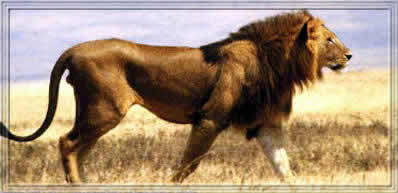Lions tend to hunt in groups, although solitary hunting is not unusual. In either case, the females do most of the hunting. When lions hunt in a group, they spread out and more or less surround the prey even though a single lion goes in for the kill. Lions prey on zebras, antelopes, domestic cattle, and buffalos.
A lion usually stalks its prey until it is 10 to 30 yards (9 to 27 m) away, then charges. Often, the prey escapes; in those cases where the lion succeeds in catching the prey, it usually hooks its claws into the prey's flanks, throws it down, and kills it by biting or smothering it. All of the lions in the pride feed on the prey, with the strongest males getting first choice.
A substantial amount of the lion's food comes from scavenging the kill of other predators, especially hyenas or wild dogs, or from eating carcasses of animals that died from disease or injury.
Lions rarely attack a human being without provocation. Some, however, become man-eaters. These are usually animals that have been made unfit for hunting by injuries or the afflictions of age. Some are the offspring of crippled lionesses that turned to feeding on human flesh.
How Do Lions Hunt?
Lions often hunt at night. That’s when they are most likely to surprise their prey. Lions mostly hunt large animals, such as zebra, buffalo, and wildebeest. Such prey can weigh twice as much as a lion. Prey this big is not easy for one lion to bring down. So when lions hunt, they often work as a team.
Hungry lions begin their hunt by searching for a herd of animals. During most hunts, lions stalk, or creep up on, their prey. Although lions can run fast, many of their prey can run faster. So lions must get as close as they can before they spring at their prey.
When lions work together, they may spread out and circle their prey to cut off escape routes. Then they creep in. Lions use their sharp claws to grab their surprised prey from behind. Or, the lions seize the prey with their powerful jaws. Then they force it to the ground.
How Do Lions Eat Their Meals?
Lions begin eating soon after they bring their prey to the ground. They use their long canines to tear away large chunks of meat. Since lions have teeth designed for tearing rather than for chewing, they swallow the chunks whole. Lions also use their tongues, which are coarse like sandpaper, to strip away hair and scrape meat off bones.
If there is plenty to eat, a pride eats together. If not, the most powerful, or dominant, males eat first. It might be a while before they finish. A male lion can eat up to 75 pounds (34 kilograms) of meat in just one meal. After the males eat their fill, the lionesses get a turn. The last ones to eat are the cubs, or baby lions.
Lions eat as much as they possibly can at each meal. That’s because a week may pass before they catch their next meal. If prey is scarce, lions will eat just about anything they can catch. This includes small mammals, birds, and reptiles.
Do Lions Compete with Other Wild Cats?
Lions do compete for prey with other big wild cats, such as leopards and cheetahs. But lions do not compete with the biggest wild cats of all—tigers. The reason that lions and tigers don’t compete with each other is that they don’t live near each other.
All tigers live in Asia. One form of tiger lives far north in the snow-covered alpine forests of Siberia. But most tigers, like this Bengal tiger, live in warm, tropical habitats. The Bengal tiger is actually the same species as all tigers. But just as an Asiatic lion differs slightly from an African lion, the Bengal tiger differs slightly from other forms of the tiger.
Like most wild cats, except for lions, tigers spend most of their lives on their own. Male and female tigers usually gather to mate between November and April. Three to four months later, a female tiger gives birth to up to six cubs. Usually, though, she gives birth to only two or three cubs.

No comments:
Post a Comment